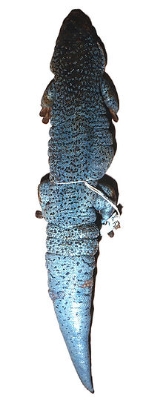
Rodrigues day gecko
Encyclopedia
Rodrigues day gecko is a now extinct diurnal
species
of gecko
s. It lived on the island of Rodrigues
and typically inhabited forest
s and dwelt in tree
s. The Rodrigues day gecko fed on insect
s and nectar.
in London
, the two others being in the Paris Natural History Museum
. These specimens have been preserved in alcohol and show a thick-bodied, robust Phelsuma. The body colour has been described as bright green with bright blue spots on the back. The underside of the tail was whitish yellow. The chin had a deep yellow colour.
s. They also liked to lick soft, sweet fruit, pollen and nectar.
s. It was quite tame and would even eat fruit
from one's hand.
Diurnal animal
Diurnality is a plant or animal behavior characterized by activity during the day and sleeping at night.-In animals:Animals that are not diurnal might be nocturnal or crepuscular . Many animal species are diurnal, including many mammals, insects, reptiles and birds...
species
Species
In biology, a species is one of the basic units of biological classification and a taxonomic rank. A species is often defined as a group of organisms capable of interbreeding and producing fertile offspring. While in many cases this definition is adequate, more precise or differing measures are...
of gecko
Gecko
Geckos are lizards belonging to the infraorder Gekkota, found in warm climates throughout the world. They range from 1.6 cm to 60 cm....
s. It lived on the island of Rodrigues
Rodrigues (island)
Rodrigues , sometimes spelled Rodriguez but named after the Portuguese explorer Diogo Rodrigues, is the smallest of the Mascarene Islands and a dependency of Mauritius...
and typically inhabited forest
Forest
A forest, also referred to as a wood or the woods, is an area with a high density of trees. As with cities, depending where you are in the world, what is considered a forest may vary significantly in size and have various classification according to how and what of the forest is composed...
s and dwelt in tree
Tree
A tree is a perennial woody plant. It is most often defined as a woody plant that has many secondary branches supported clear of the ground on a single main stem or trunk with clear apical dominance. A minimum height specification at maturity is cited by some authors, varying from 3 m to...
s. The Rodrigues day gecko fed on insect
Insect
Insects are a class of living creatures within the arthropods that have a chitinous exoskeleton, a three-part body , three pairs of jointed legs, compound eyes, and two antennae...
s and nectar.
Scientific synonyms
- Phelsuma edwardnewtoni VINSON & VINSON 1969
- Phelsuma newtoni BOULENGER 1884
- Phelsuma edwardnewtoni - KLUGE 1993
- Phelsuma edwardnewtoni - RÖSLER 2000: 101
Description
This day gecko is now extinct. It was described also as P. newtonii, yet this name was also used as a synonym for Phelsuma gigas. P. edwardnewtoni belonged to the largest day geckos. It reached a total length of about 23 cm. Earlier investigators describe the animal as being quite common. However, this species has not been sighted since 1917, in spite of thorough searches in the 1960s and 1970s on Rodrigues and all offshore islets. Today, only 5 preserved specimens remain, three of which are in The Natural History MuseumNatural History Museum
The Natural History Museum is one of three large museums on Exhibition Road, South Kensington, London, England . Its main frontage is on Cromwell Road...
in London
London
London is the capital city of :England and the :United Kingdom, the largest metropolitan area in the United Kingdom, and the largest urban zone in the European Union by most measures. Located on the River Thames, London has been a major settlement for two millennia, its history going back to its...
, the two others being in the Paris Natural History Museum
Muséum national d'histoire naturelle
The Muséum national d'Histoire naturelle is the National Museum of Natural History in Paris, France.- History :The museum was formally founded on 10 June 1793, during the French Revolution...
. These specimens have been preserved in alcohol and show a thick-bodied, robust Phelsuma. The body colour has been described as bright green with bright blue spots on the back. The underside of the tail was whitish yellow. The chin had a deep yellow colour.
Habitat
P. edwardnewtoni has been observed on coconut trees and other palms. Their habitat has been largely destroyed by humans and introduced animals such as cats and rats, which may have been the main cause of their extinction.Diet
These day geckos fed on various insects and other invertebrateInvertebrate
An invertebrate is an animal without a backbone. The group includes 97% of all animal species – all animals except those in the chordate subphylum Vertebrata .Invertebrates form a paraphyletic group...
s. They also liked to lick soft, sweet fruit, pollen and nectar.
Behaviour
P. edwardnewtoni was documented as being unafraid of humanHuman
Humans are the only living species in the Homo genus...
s. It was quite tame and would even eat fruit
Fruit
In broad terms, a fruit is a structure of a plant that contains its seeds.The term has different meanings dependent on context. In non-technical usage, such as food preparation, fruit normally means the fleshy seed-associated structures of certain plants that are sweet and edible in the raw state,...
from one's hand.

